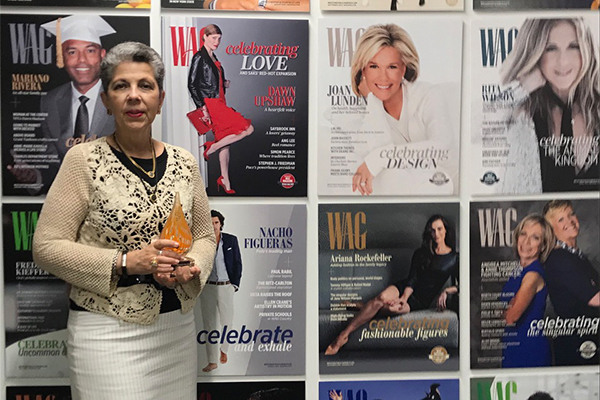Crisis has had a way of bringing international architect Robert Siegel from Manhattan to Katonah.
After 9/11, he moved from Battery Park City to a Katonah house that he designed, earning an American Institute of Architects (AIA) High Honor Award.
Ten years later, amid the Covid pandemic, he decided to relocate Robert Siegel Architects ”” which had had several homes in Manhattan, most recently in the Chrysler Building ”” to a Katonah storefront.
“The Chrysler Building is a beautiful building and it”™s steps away from Grand Central,” he says of one of the finest extant examples of Art Deco architecture. “Every day I”™d walk by the lobby,” he adds of the ancient Egyptian temple-like space, which is embellished with Carrera marble and English boxwood and whose elevator cars are each distinct. “After that, it”™s an office building like any office building in New York City.”

Now he”™s in a Katonah storefront where he and his staff of 15 can connect with the community.
“People stop by our windows to look at the models of the buildings we design,” says Siegel, who is the principal in his firm. “There”™s this conversation: What do architects do? That”™s been great.”
What this architect does is a range of work, from home design in the style of what he calls “sumptuous Modernism” ”” “I”™m a Modernist through and through Modernist in a forward-looking way”; to historic preservation at the New York Botanical Garden in the Bronx and Purchase College”™s Conservatory of Dance (garnering an AIA Westchester Historic Preservation Honor Award for the latter); to renovations for such retail spaces as Bergdorf Goodman and Saks Fifth Avenue, both at their Manhattan flagships and nationwide. In Brewster, he”™s creating a dining room with a retractable roof in a horseshoe-shaped garden at the Italian restaurant Rraci”™s.
But what makes Siegel different from many other architects is a particular kind of public work, for the United States government and those of other countries. He designed the stunning green, glass Republic of Korea (South Korea) Embassy in Beijing, a 1995 commission resulting from taking first place in a competition for best design. At home, he”™s designed border stations ”” officially Land Ports of Entry ”” that welcome immigrants and visitors to our country, like the one in Calais (pronounced “Callus” in English, “Cal LAY” in French), Maine.
What makes these buildings especially challenging, Siegel says, is their seeming contradiction. They”™re at once transitional and permanent, accessible and yet necessarily formidable. Taking stock of a proposed building”™s surroundings and the materials native to those, Siegel says he plays with scale, using windows and doors to make official buildings less forbidding. At Calais, he used aluminum and the inspiration of Maine”™s distinctive rocky landscape and natural light, so beloved by artists like Edward Hopper.
“The façade panels are expanded aluminum mesh with a bright anodized finish,” he says. “The combination of embossing to create the rock-like form, the open weave of the mesh and the bright anodized finish”¦reflects the light conditions around them and appears to change color with the sky.”
The result is a structure that is both imposing and enticing.

(photo by Gabe Palacio)
Like Alfred Lord Tennyson”™s Ulysses, Siegel would say, “I am a part of all that I have met.” That”™s especially true of his childhood in Levittown, Long Island, the first in a series of postwar suburban developments in the Northeast and Puerto Rico for returning GIs and their families, created by William J. Levitt and his firm, Levitt & Sons. (Initially, the developments excluded African Americans, which led to the involvement of the Rev. Martin Luther King Jr. in the 1950s and legislative change.)
As a high school student in the late ”™70s, Siegel worked on some of the Levittown houses while apprenticing with a local architect. But he also crewed and played piano in a jazz band. He earned academic scholarships to the Syracuse University School of Architecture, from which he received a Bachelor of Architecture degree, and to the Facolta di Architetturà di Siracusa in Florence, Italy ”” a city that is no slouch when it comes to great buildings. Siegel calls his time in Italy “the best year of my life,” as it brought together many of the things he loves.
After practicing and teaching in Boston, Siegel won another academic scholarship, this time to attend Columbia University Graduate School of Architecture, Planning and Preservation, where he earned his Master of Science in architecture and building design. In 1989, he went to Russia to participate in an exchange program with the Moscow Institute of Architecture. Two years later, he established his practice, working with a partner for 10 years before heading up his own firm. Siegel also taught undergraduates and graduate students at the Boston Architectural Center, City College, New Jersey Institute of Technology, Parsons School of Design, Pratt Institute and Syracuse University.
Now he”™s engaged in another kind of teaching as well ”” educating the Katonah community by being in its midst.
“What”™s amazing is that people come in off the street and thank me,” Siegel says, marveling. “They say, ”˜This is so great for our town.”™”
For more, visit robertsiegelarchitects.com.






















